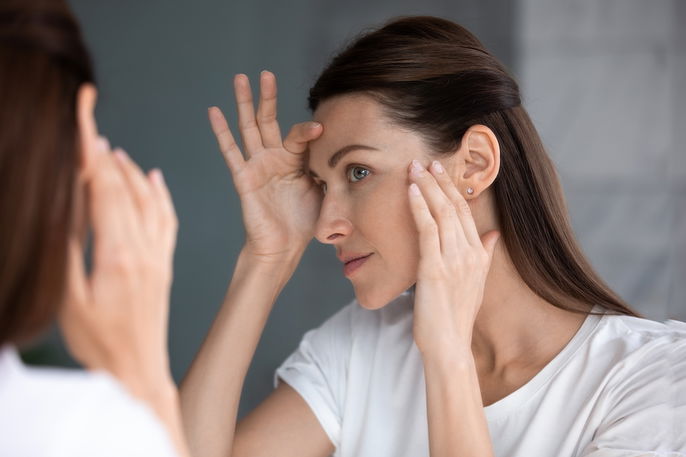White spots on the face can emerge due to normal aging or frequent sun exposure and may not be related to any serious problems. However, white spots can also be related to skin conditions like vitiligo or pityriasis alba. They can also be caused by contact with chemical products.
Generally, white spots emerge on the face due to abnormalities with melanocytes. These cells a responsible for melanin production and give skin its color, and can become damaged from illness, exposure to toxins or aging.
If you notice one or more white spots on the face, you should see a dermatologist for assessment to identify a cause and start treatment as appropriate.

What causes white spots on the face?
The main causes of white spots on the face are:
1. Normal aging
Reduce melanocytes and melanin production are commonly associated with aging. This can lead to white spots that usually first emerge on the face, and then appear on other parts of the body.
What to do: In this case, treatment is not necessary, as these are normal, expected changes.
However, you may benefit from consulting a dermatologist. Although treatment is not necessary, the doctor will recommend using sun screen, He or she may also prescribe a corticosteroid ointment to help diminish the spots and improve skin appearance.
2. Frequent sun exposure
Frequent sun exposure may also be related to white spots on the face that appear over time. These generally affect the arms first, and are associated with inflammation caused by UV rays on the skin.
What to do: White spots on the face and arms caused by frequent sun exposure do not need treatment. However, more can start to appear if frequent sun exposure persists. Using sun screen can be useful for protecting spots from becoming whiter.
You can consult a dermatologist for skin treatments to help improve skin's appearance. This can be achieved with retinoid and corticosteroid ointments.
3. Chemical products
Exposure to certain chemical products like phenols and hydroquinine can be a risk factor in some jobs, like rubber or leather production. Acid exposure (to acids from chemical peels for example) can also be a risk factor for white spots on the face or other areas of the body.
The white spots appear due to damage to melanocytes caused by these chemicals, or interference with normal melanin production due to these chemicals.
What to do: It is important to avoid direct contact with chemical products and to use adequate personal protective equipment as necessary. You should not use chemical peels or hydroquinone without your doctor's advice.
If you suspect that white spots on the face are emerging from chemical products, you should see a dermatologist for evaluation and treatment, which may involve oral or topical corticosteroids.
4. Nutritional deficiencies
Malnutrition or a nutritional deficiency, like iron, copper or vitamin B12 deficiency, can lead to white spots on the face and other parts of the body. Anemia and symptoms like weakness, numbness, weak nails and hair loss can occur with these types of deficiencies.
What to do: It is important to maintain a healthy and balanced diet to ensure you are adequately nourished. However, if you suspect you may have a nutritional deficiency, it is important to consult a family doctor dor assessment. The doctor may advise supplementation with iron and vitamin b12, as well as a dietary consult to ensure your intake is sufficient for your basic body functions.
5. Pityriasis alba
Pityriasis alba is a skin condition that causes white spots due to small inflammatory responses. The face is commonly affected, however spots can also appear on the arms and trunk. The spots may have a red appearance at first before turning white.
What to do: White spots caused by pityriasis alba generally disappear on their own within a year without any specific treatment. However, you can use sun screen to improve the spots' appearance. In addition, using moisturizers can help to reduce skin peeling over the spots.
You are also advised to see a dermatologist, especially if the spots are red and itchy. The doctor may prescribe corticosteroid ointment to relieve symptoms recover any lost pigmentation.
6. Vitiligo
Vitiligo can cause white spots on the face, generally around the mouth and eyes. Other parts of the body can also be affected, like the neck, hands and trunk. This condition is associated with a reduced amount of melanocytes in the skin, leading to large white spots that do not cause any symptoms.
What to do: If you suspect you may have vitiligo, you should see a dermatologist for assessment and treatment, which may involve phototherapy or oral corticosteroids. These treatments can worsen the skin's appearance before improvements are noted.






























